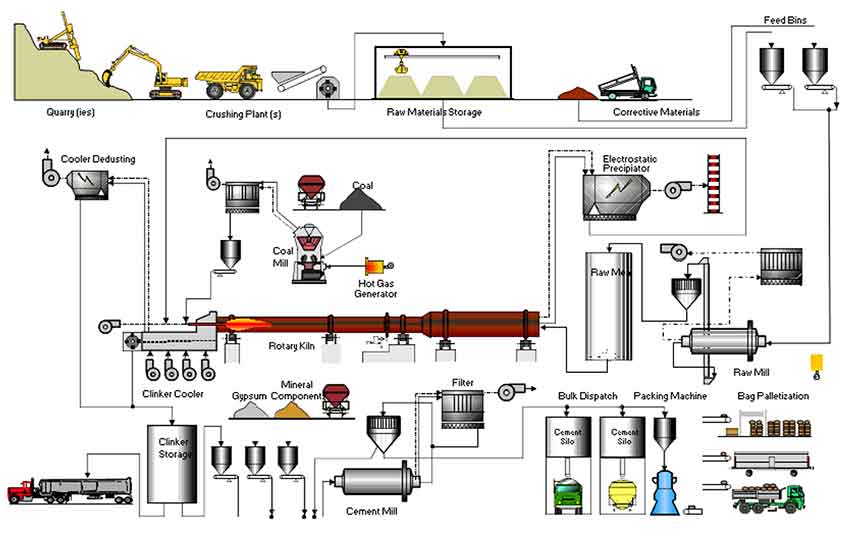Steps of Cement Production Process
Cement is one of the most common and important building materials. It is a very critical ingredient because only cement has the ability to increase the viscosity of concrete, which in turn provides the ability to lock sand and gravel together in concrete mixtures. But most of us may not know how cement is produced. Here are several simple steps that will help us understand the cement production process.

I. Crush and pre-homogenization
Crush
In cement production process, most of raw materials must be crushed, for example, limestone, clay, iron ore, coal, etc. In cement production, limestone is the main raw material whose amount is the largest in all the raw materials. After being mined, usually limestone is in large size and high hardness, it is necessary to crush it into small pieces in order to produce cement.
Pre-homogenization of raw materials
Pre-homogenization technology is the use of advanced stacking recovery technology in the process of raw material recycling to achieve homogenization of raw materials, so that the material field can have the function of storage and homogenization.
II. Preparation of raw materials
In the cement production process, each ton of portland cement requires the grinding of at least 3 tons of materials which include all kinds of raw materials (fuel, clinker, gypsum, mixture, etc.). According to statistics, for the dry cement production line, power consumed on the grinding takes more than 60% of the total power consumption, including more than 30% consumption used on raw material grinding and about 40% on cement powder grinding. Therefore, choosing reasonable grinding equipment and technology, optimizing process parameters, operating correctly and establishing a good operation control system are of great significance to ensure product quality and reduce energy consumption.
III. Homogenization of raw materials
In the new dry process of cement production, the stability of raw material composition is the premise to ensure the stability of clinker sintering heat regulation. Raw material homogenizing system plays a final role in controlling the composition of stabilized kiln.
IV. Preheating decomposition
The length of rotary kiln can be shortened by using preheater instead of partial function of rotary kiln to preheat and partially decompose raw materials. When the air-material heat transfer process in the kiln occurs in a suspended state rather than in a stacking state, the air released in the kiln will be fully mixed with the raw material, and the contact area between the air and the material will be increased, so as to achieve high-speed heat transfer and efficient heat transfer. This improves the production efficiency of kiln system and reduces the heat consumption of clinker combustion.
Material dispersion
80% of the heat transfer occurs in the inlet flue. The material entering the preheater flue is turned over and moved under the impact of high speed air, and is eventually dispersed.
Air-material separation
When the air carrying powder enters the cyclone separator, it is forced to rotate in the annular space between the cyclone separator cylinder and the inner cylinder (exhaust flue). It rotates downward from the cylinder to the cone until the bottom of the cone, and is upturned and finally discharged from the exhaust passage.
Precalcining technology
Precalcining technology is a technological leap of cement calcining process. The calciner is innovatively set up between the preheater and rotary kiln with a newly added rising flue and a fuel injection device, which makes exothermic process of fuel combustion and endothermic process of carbonate calcining of raw materials quickly occur as a suspending or a fluid state in the calciner furnace. The calcining rate of raw materials can increase to 90%. The carbonate calcining moves from the rotary kiln to the calciner furnace, which reduces the heat load of the kiln, prolongs the life of the kiln lining and is conducive to large-scale production. Because the fuel and raw materials can mix evenly, fuel combustion heat can transfer to the materials timely, so that the combustion, heat transfer and carbonate calcining process are optimized. Thus it has a series of excellent characteristics of high quality, high efficiency, low power consumption, etc.
V. Cement clinker sintering
After preheating and precalcining in cyclone of the raw materials, the next step is to enter the the rotary kiln for clinker sintering.
The rotary kiln is a huge rotating furnace as the heart of cement making process. Here, raw materials are heated up to 1450℃. This temperature begins a chemical reaction so called decarbonation. In this reaction materials (like limestone) release carbon dioxide. High temperature of the kiln makes slurry of the materials.
In the rotary kiln, carbonate is further decomposed rapidly with a series of solid phase reactions. With the materials’ temperature is up, other minerals in the materials will be dissolved into liquid phase, and generate a large amount of clinker. As cement clinker sinters, the temperature decreases, and then under the function of the cooling machine high temperature clinker will be cooled and discharge to storage.
VI. Cement grinding
Final process is the cement grinding. But power consumption is the largest in the last process of cement manufacturing.
There is a horizontal filled with steel balls. Clinker reaches in this rotating drum after cooling. Here, steel balls tumble and crush the clinker into a very fine powder. This fine powder is considered as cement. During grinding gypsum is also added to the mix in small percentage that controls the setting of cement.
VII. Cement package
Cement production plant has two methods of storing cement: bag or bulk. Cement is directly conveyed to the silos (silos are the large storage tanks of cement) from the grinding mills. Further, it is packed to about 20-40 kg bags. Only a small percent of cement is packed in the bags only for those customers whose need is very small. The remaining cement is stored in cement steel silo and waited to be transported in bulk by mean of trucks, rails or ships.
 Español
Español
